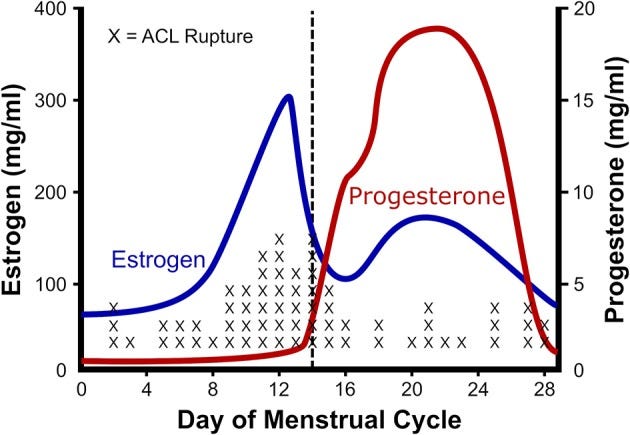
As someone who frequently collaborators with dancers, choreographers, and movement artists, I’m passionate about sharing the effect of hormonal health on physical performance.
I’ve worked with several dancers who experience cyclical symptoms like period pain, and offering rest as care during their menstrual bleed is not always possible for them — and to be honest, it’s not possible for a lot of other folks in a range of professions!
With that, said, understanding how hormones like estrogen, progesterone, and testosterone interact with our muscles, joints, and bones can offer some insight into our physical performance and possibly minimize the risk of injury.
The Menstrual Cycle & Hormonal Fluctuations
The menstrual cycle can be broken down into four phases:
menstruation (your period)
follicular phase
ovulation
luteal phase
Let’s break down what’s happening hormonally during these phases.
Menstruation
During your bleed, estrogen levels are usually at their lowest while a group of lipids (fats) called prostaglandins are usually elevated.
Prostaglandins are produced by nearly all our cells and are part of how the body deals with injury and illness. They’re made at sites of tissue damage or infection and cause inflammation to support the healing process.
High levels of prostaglandins can cause cramping, fatigue, and bloating - not to mention increase sensitivity to pain, making high-impact or strenuous exercises feel more difficult.
Coupled with low estrogen - which may lead to decreased joint stability and muscle strength - this is a great time for many folks to take rest whenever possible. Personally, I noticed a huge shift in pain levels when I stopped my usual exercise routine at this point in my cycle.
However, many folks that I work with are not able to completely rest their bodies at this time, so I often recommend building in more time to rest and recover where possible.
For my performing friends, this means taking it easy before your shows and possibly extending your cool-downs.
Follicular Phase (bleed to ovulation)
During this phase, estrogen begins to rise.
Estrogen receptors are present in all musculoskeletal tissues: muscle, bone, ligament, and tendons. Estrogen is known for its positive effects on muscle repair, joint flexibility, and bone health, and it can also improve mood and energy levels.
Higher levels of testosterone in this phase may also enhance energy and motivation levels - so for cycling athletes, this may be a time to push the intensity of your workouts or try something new.
But a word of caution as we heads towards ovulation, our hormonal peak in our cycles.
Ovulation
Ovulation occurs when an egg is released from the ovary. Estrogen levels peak during this time, while progesterone begins to rise.
While this may be a time for some folks to experience their highest levels of muscle strength and intensity, I want to include an extra note of caution on ligament and tendon laxity.
One study found that knee laxity increased between 1-5mm in the follicular phase, depending on estrogen levels. Given that each 1.3 mm increase in knee displacement increases the risk of ACL injury by 4x, this could explain the higher risk of injuries like ACL rupture.
Given its key role in musculoskeletal function, it makes sense that female athletes suffer from more ACL (a ligament in the knee) ruptures than males and also why menopause (with long-term lower levels of estrogen) is linked with higher levels of musculoskeletal injury.
In this phase of the cycle, some may choose to take advance of increased flexibility, but for those looking to encourage joint stability, you may want to exercise extra caution as you approach ovulation and focus on balance and proprioception.
Luteal Phase
The luteal phase follows ovulation and is characterized by rising levels of progesterone and the gradual decline of estrogen.
Progesterone is associated with relaxation and calming effects (including better quality sleep!), but it can also lead to water retention, bloating, and fatigue.
For cycling athletes, higher levels of progesterone can cause less flexibility in the joints. Coupled with lower estrogen, some may also experience fatigue and more muscle stiffness.
One study found that injury risk was elevated in this phase of the cycle for professional footballers (soccer players).
This may be a time to opt for more moderate intensity activities like steady cardio (to maintain cardiovascular health without too much muscular/joint stress), restorative mobility work, and again increasing cooldowns/active rest times.
And be sure to keep up the caloric intake - studies suggest that daily energy intake is greater in the luteal phase of the menstrual cycle (around 200-300 calories more per day compared to the follicular).
Want to build your own movement plan?
Moving with the phases of our cycle is just one way that we can more deeper attune to our body’s needs and adjust accordingly.
If you’re interested in learning how to track your cycle to help you work in harmony with your body, my Winter Cycle Charting Series begins this Sunday! You’ll learn how to chart and interpret your cycle - and the course includes one individual session so you can feel confident in your own practice.
Use the discount code CYCLESTACK for 10% the class series
To learn more, visit helloearthbody.com/class-series
With gratitude,
Kate



